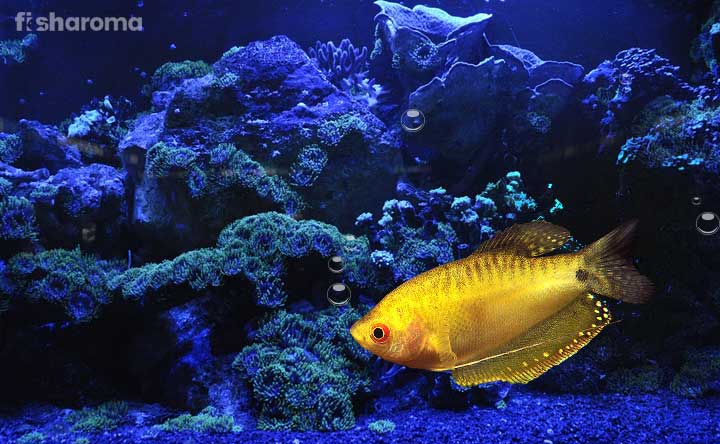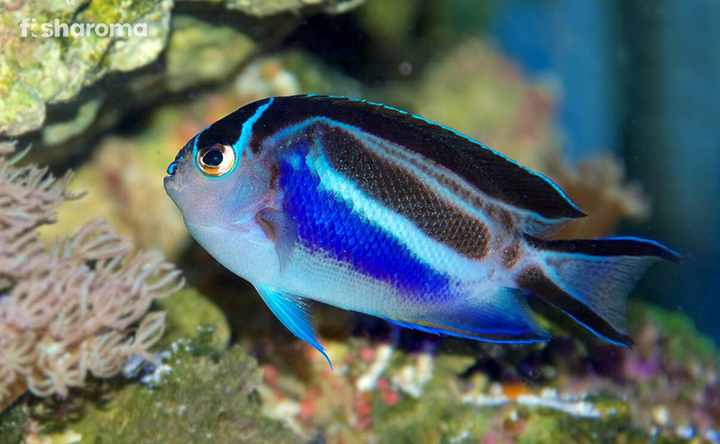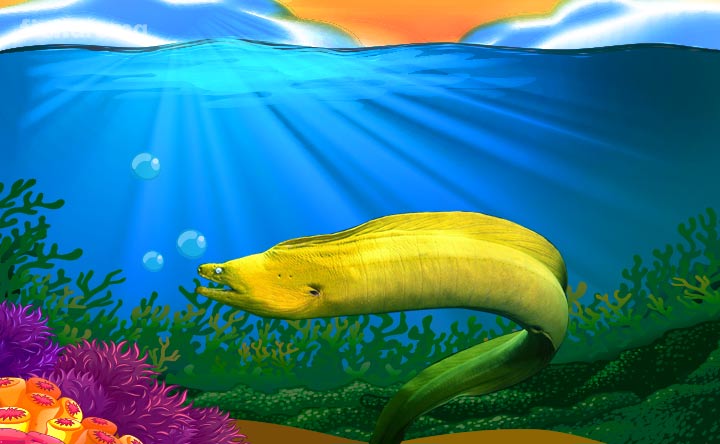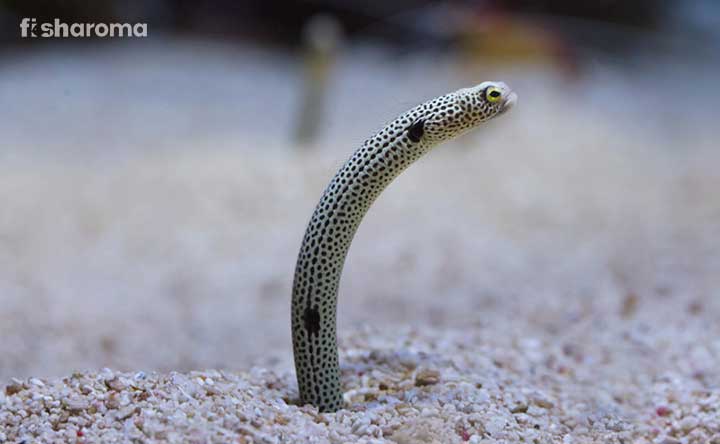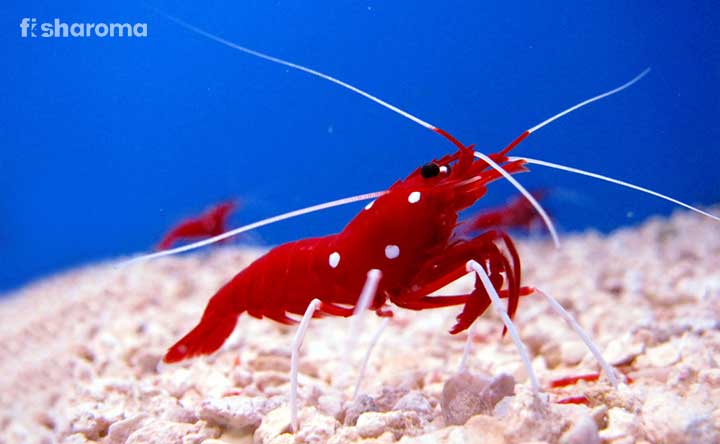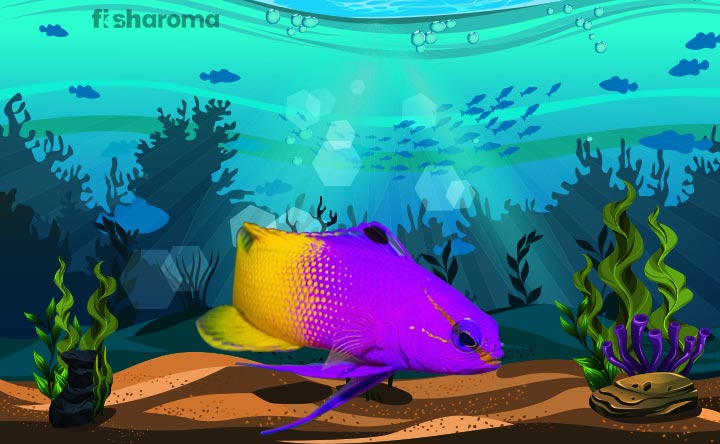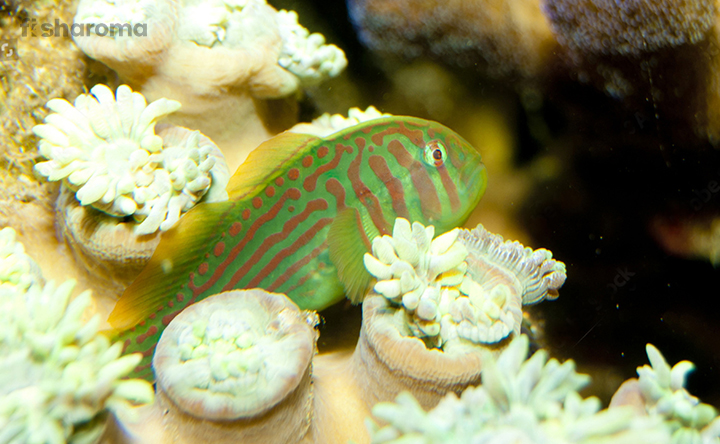Dragon Wrasse: A Broader Perspective On Its Care Guide
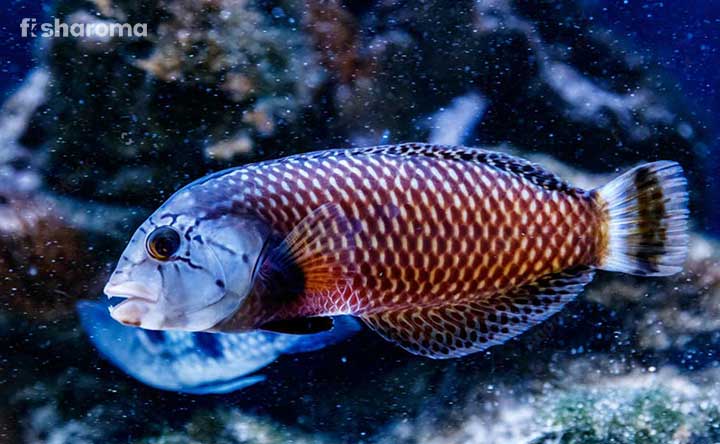
Dragon Wrasse or Rockmover Wrasse is a saltwater fish, with an astounding appearance. The territorial fish exhibits a super aggressive nature, but that doesn’t come in the way of choosing the species while thinking about keeping one inside the tank. It might not be one of the typically gentle fishes, but its nature is unique in the very truest sense of the term.
To be frank, despite requiring a moderate level of maintenance, petting the fish is not everybody’s cup of tea, because they are not schooling fishes, rather a loner. The positive thing is that the fish only needs its thriving environments and that shouldn’t be a concern for aquarists, because they know what they have signed up for.
Key Specifications of Dragon Wrasse
The following table is going to guide you in terms of getting quick information regarding the majestic Dragon Wrasse.
| Also Known As | Red Belly Wrasse, Reindeer Wrasse, Striped Wrasse, Olive-scribbled Wrasse, Masked Wrasse, Bar-cheeked Wrasse, Carpet Wrasse, Sand Wrasse |
| Origin | Indo-pacific zone |
| Lifespan | More than 10 years |
| Colours | Adult: Grey, white, & red Juvenile: Green, white, red , & black |
| Temperament | Aggressive |
| Size | Mostly around 10.5 inches |
| Diet | Carnivorous |
| Reproduction | Oviparous |
| Maintenance Requirements | Moderate |
| Tank Size | Around 10 gallons |
| IUCN Status | Least Concern |
Overview
Dragon Wrasse is the sole species of the Novaculichthys genus, and its scientific name is Novaculichthys taeniourus. They are a part of Labridae, a saltwater fish family consisting of many other species of wrasses.
These diurnal marine fishes are found in abundance in the wild, and their growing popularity has made them so frequent in the pet trade, disregarding their poor captive breeding power. The vibrant hues of their body completely change while the species attains maturity. In the wild, they mark and protect their territory, and in the process, their aggressiveness is often shown. While in the pet trade, with proper care and maintenance, they can be an excellent addition to an aquarium.
Origin and Habitat of Dragon Wrasse
The Dragon Wrasse naturally occurs in the Indo-pacific regions along with Panama, Micronesia, and Melanesia. The fish also calls the Hawaiian Islands, the Gulf of California, and the Coast of Africa home. Their distribution is further stretched to Japanese provinces of the Ryukyu Islands and Australian zones of New South Wales and Howe Islands. In Mexico, they are found in Cabo San Lucas and La Paz areas, the eastern coast of Baja, with the central Gulf and Guatemala.
The fishes are found thriving in shallow waters (with a depth of 45-82 ft) surrounded by lagoons, seaward reefs, coral structures, with mostly a sandy and grassy surface. Their reef zones are always semi-exposed and there are lots of rocks and rubbles around their domain.
Appearance of Dragon Wrasse
The stunning fish exhibits different sets of colours and unique features in juvenile and adult forms. The juvenile fish has bright shades, but it is transformed into a completely different look when it becomes an adult. The change is so drastic that a juvenile and an adult Dragon Wrasse might make you think that they are two different species. Appearance-wise, there is no similarity between these two stages of its life.

The compressed body of the fish has an oblong shape, along with a scaleless head similar to a wedge. Their gill covering has a couple of scales and behind their eyes, there are some vertically placed scales. Their dorsal and pelvic fins are long and slim, hanging from their body. While the fishes’ dorsal fin exhibits 9 fins, their anal fin is studded with 3 spines. Both the fins have almost the same number of rays ranging around 13.
Their mouth is terminal and in each of their jawline (both upper and lower), they have a couple of pairs of canines.
They showcase a pair of appendages, though the latter part is only applicable for juveniles and while they grow, this feature vanishes. Their moniker (as mentioned in the table), “Reindeer Wrasse” is given because of these appendages, and when they grow old and lose it they are only Dragon Wrasse and can’t be termed as the Reindeer Wrasse.
Size
The fishes are usually around 10.5 inches, but some can grow to be as large as 12 inches as well.
Colour
Juvenile fishes have colours like burgundy, green, red and their bands are brown in shade. The colour variation depends a lot on their geographical distribution. For example, you can see while juvenile Dragon Wrasses, found in the Western Pacific zone are more prone to have a burgundy based body colour with white marking, the Hawaiian fishes are more likely to have a green body.
The entire body has itsy-bitsy white spots and the belly is essentially pink. Their dark coloured fin rays give an impression of ruffles around their body. The eyes of juvenile fishes have brown rays-like patterns surrounding them. Their membranes seem translucent when exposed in front of lights.
By the time the fishes become adults, they start to exhibit a combination of brownish-green body and each scale has a white spot. The structural honeycomb pattern of the colouration is prominent and their caudal, dorsal and anal fins are all black, but there is a white mark observed in their caudal fin. The pectoral fin is spotted with a yellow shade. Their tail is white with black marks on it and their frill like fin rays are gone.
Behaviour of Dragon Wrasse
The Dragon Wrasse follows many survival strategies to dupe their enemies or predators in the wild. Juvenile fishes prefer to float like seaweed or any algae, just to be inconspicuous in front of any potential threats. They look convincing because of their body colour, which helps them camouflage against the colourful coral or reef background.
However, whenever they are alarmed about any predator getting close to them, they quickly take a plunge with their head, turning downwards into the seabed and hiding under the sand. They are often called benthopelagic for this reason also. During this, they can slowly relocate to other locations, being constantly under the sand and leaving no trace on the water. These are common defensive tactics for the entire species, regardless of their age.
The fish is commonly known as Rockmover and that is because of their frequent tendency to move rocks, pebbles, corals and rubbles while looking for potential food items. While the rocks are pulled out by their mouth, they use snout to push the rocks afterwards.
In the wild, two adult fishes will make a pair to hunt and search for food. While one fish stays committed to moving the rocks only, the other one will take out the prey hiding underneath the rock. However, this is not observed in juvenile fishes as they actually stay alone.
The species is highly territorial in the wild and also in captivity. They will compulsorily show aggression if any similar fish can come to claim its territory.
Like many other Wrasses, some of the female fishes can be transformed into males, in the latter part of their life.
Lifespan of Dragon Wrasse
The average lifespan of a Dragon Wrasse is around 10 years, but in some cases, they can live for a couple of years more.
Diet of Dragon Wrasse
The carnivorous fishes only feed on smaller fishes, invertebrates, and crustaceans that they find themselves like Sea Urchin, Starfishes, Snails, Shrimps, algae. So, in your aquarium, you can try various live foods as well as pellet and marine flake foods. While live foods are nutritious and ideal for the fishes, their dietary chart should mostly consist of them. The commercial ones (pellet and flake) should be given in lower quantities.
You can feed them thrice a day, but the proportion needs to be the same every time. Not too high, not too low, just a moderate amount of food should be provided. You can give your pet Dragon Wrasse the following food
- Brine Shrimp
- Tubifex
- Blackworm
- Opossum Shrimp
- Any fish from the Silversides group
- Small Crab
- Snail
Tank Requirments of Dragon Wrasse
Since the fish comes from a saltwater tropical background, you can set up a standard saltwater aquarium. Owing to its territorial nature, and large size, the fish requires a sizable tank, with all the conditions that can nurture the fish. Ensure that the fish should be able to practice its typical rock moving traits, and many others in the tank, or else it will lose its natural vigour.
Don’t make them stay in any reef tank, because they can’t survive there.
Regardless of the tank size and its type, it should be clean and hygienic, without any doubt.
Tank Size
While you can temporarily keep a juvenile inside a 20-gallon tank, it should be given a much bigger tank while it grows. So, we recommend you to set up a large tank, at least 100-gallon to say the least. This size is perfect for an adult fish as well. However, the fish doesn’t shy away from roaming around, rather it needs space so even if you can arrange for something bigger, like a 125-gallon tank, that would be the best.
Tank Lid
The energetic fish can sometimes jump and for that, the lid of the tank should be tightly placed. It will also act as a shade or shelter for the tank so that nothing can come inside. Especially, if you have any inquisitive four-legged pet who would like to play with your fish.
Substrate
Setting up the surface is extremely important because the fishes instinctively explore the substrate. In order to provide a natural marine setting, you should provide plenty of sand, soft gravel, and rocks. Make sure the ingredients that you are placing inside the tank are not rough, because that will be detrimental for the fish. Since the fish will be scattering the rocks, out of their behavioural compulsion or diving into the sand, their mouth can be badly injured.
The thickness of the sandy surface should be around 2-4 inches so that the fishes should be able to hide as they do in nature, under the sand, inside the burrows.
Filter
The fish stays in a strong current, so provide a filter that can provide strong filtration.
Ornamentations
For decorations, you can start with cave and hideout like structures, so that your fishes can stay comfortable inside. Just keep in mind, don’t decorate the tank profusely because despite their burrowing nature, every now and then, they still need room to swim. Nothing should prevent them from swimming freely. The fishes will feel stressed if they can’t get that sufficient space.
Lighting
These fishes can get exposed to sunlight in their natural setting, but not for a long time. So, you can place the tank somewhere inside the room where proper sunlight comes. Quite obviously, a strong light should be provided from your end and you can browse from any commercially available tank lights.
Presence of Flora
There is not any specific requirement for the plants, but you can keep a layer of grass at the bottom. You can keep some, but don’t fill the tank with it.
Cleaning Method
When you clean the tank, make sure you keep the fish out of it and temporarily place it in other tanks. The gravels, the caves, and the glass wall of the entire tank should be cleaned properly. Use a towel to rub and rinse off the dirt and make sure the tank is in pristine condition. You can trim the growing plants periodically. If you see there are excessive algae, you need to clean them too by wiping or using an algae scraper.
Water Type for Dragon Wrasse
The water needs to maintain a certain salinity level, with a range of 1.020-1.025. Also, check the water parameter and quality every week to see if there is any drop or spike in the mentioned parameters.
Temperature
The suitable water temperature for a Dragon Wrasse is 22.2-25.5 Degrees Celsius. They don’t have the reputation of withstanding temperature fluctuations well, so you should be careful regarding maintaining the range for the water tank.
pH Level
The pH level for the tank water should be 8.1-8.4.
Replacement Procedure
The water change is a weekly process, and since these tanks have high water volume, don’t replace the entire amount at once, rather change the water gradually, and partially.
Compatibility of Dragon Wrasse
With its territorial nature, the Dragon Wrasse is less likely to stay peacefully with any fish. They might feel threatened by bigger fishes or can be a threat themselves to smaller ones. Young Dragon Wrasses are stressed if they don’t find enough space to swim, it could be because of incompatible tank mates. They will subsequently refuse to consume food, and will surely hide throughout the day.
So, is there no one that a Dragon Wrasse can approve of? Well, let’s see!
Suitable Tankmates
You can try keeping Triggerfishes, Grunt Fishes, Snapper Fishes, Hawkfishes, and groupers for your Dragon Wrasses.
Unsuitable Tankmates
Almost all fishes are unsuitable, except for the above-mentioned ones. Most of the small invertebrates, crustaceans, and other fishes will be eaten by the fish. So, they are best kept single if you really want them to thrive.
Breeding of Dragon Wrasse
Breeding in captivity shows a very less success rate as they are difficult to breed.
In the wild, the male and female court and the female goes up to a different zone, mostly on the upper side or rather the pelagic zone, the male follows her and then they stay side by side. After this, the female Wrasse releases her eggs which are spherical and sizing around 0.02 inches. The male Wrasses fertilize the eggs and then the eggs keep on floating in the ocean current for about 75 days, followed by a successful hatching phase.
Diseases of Dragon Wrasse
Dragon Wrasses are usually a healthy and hardy species, but they can catch common diseases that are exclusive to saltwater species. They might be affected by some parasitic problems, but there is no specific observation regarding this aspect.
We strongly suggest that, if you notice your fish has some irregular eating or moving patterns, or any sudden behavioural change, then consult a veterinarian without any delay.
Summary
While the Dragon Wrasse is a challenging species to pet, it is worthy of everybody’s attention. Like many other saltwater fishes, the Dragon Wrasse is studded with vibrant hues. With an amusing predatory nature observed in the wild, the fish enhances its surroundings. Whatever research and first-hand dealing experience have gathered, we have more unknown things to discover about these fishes in the future. Not so good with staying with other fishes, the Dragon Wrasse likes to live its life like a lone emperor.
Other Similar Care Guides
Here are three more saltwater species that you might be interested in
- Panther Grouper – The fish has an aggressive nature and it is carnivorous by nature. They occur in huge numbers in the Indo-Pacific zone.
- Dwarf Lionfish – The Saltwater fish can join the group of wonderful underwater creatures who look breathtaking. This is mainly the genus and it has four different species, namely, Dwarf Fuzzy, Fu Man Chu, Hawaiian, and Zebra Lionfish.
- Fire Shrimp – The peaceful shrimp is beautifully coloured in red. The nocturnal species can stay with other fishes inside the tank.


